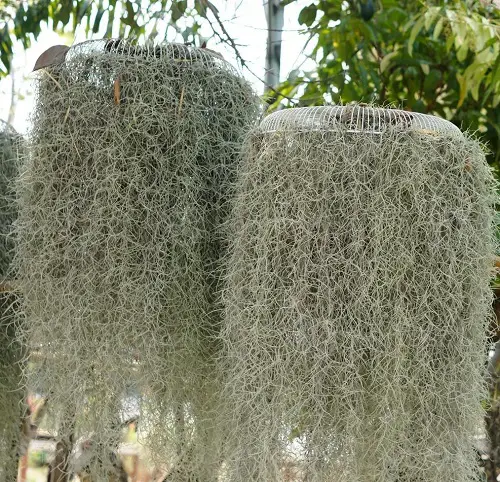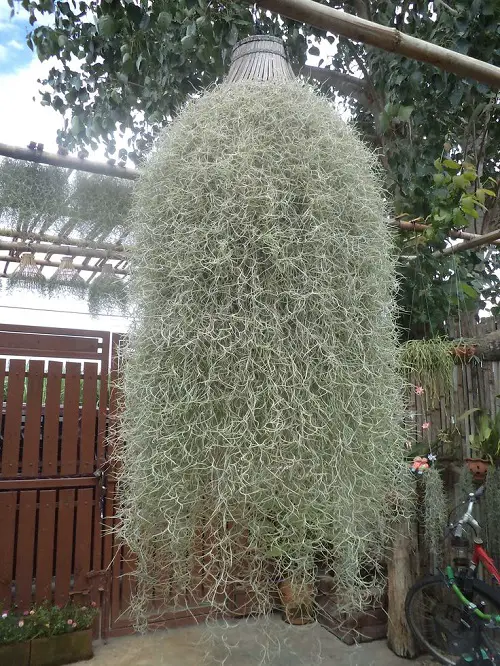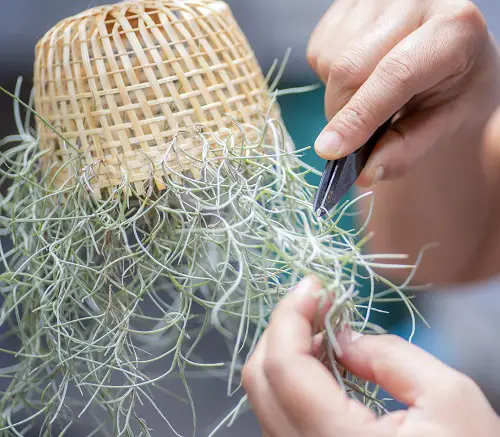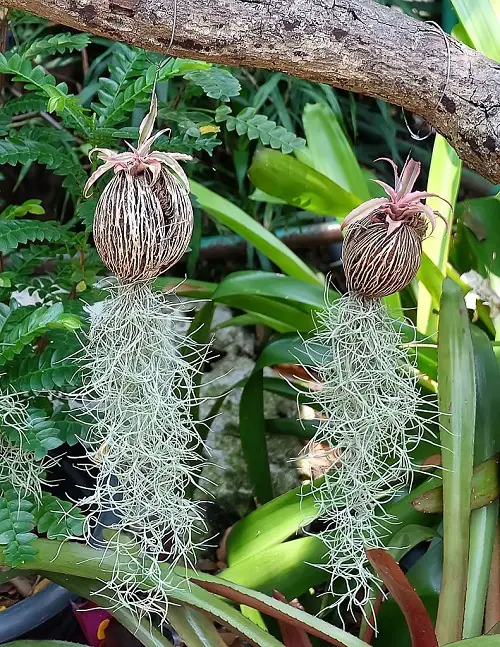Want to Grow Spanish Moss but don’t know the proper care? Don’t worry! We have the best guide so you can grow it with ease.
Ready to Grow Spanish Moss? From pot size to growth and care and all Spanish moss needs, here’s a quick and easy guide!
Botanical Name: Tillandsia usneoides
Common Names: Spanish Moss, Tree Hair, Old Man’s Beard, Kali’s Hair, Spanish Beard
8 Best Portulaca Growing Tips | Moss Rose Plant Care
Spanish Moss Information
Origin
- Historical Roots: Indigenous peoples’ interactions with Spanish explorers led to the plant’s association with the Spanish presence, though it’s native to the southeastern U.S. and Central America.
- Cultural Significance: Spanish moss symbolizes Southern identity, seen in art, literature, and cultural representations, embodying the region’s history and landscapes.
Flowers
Appearance: The small, pale green flowers of Spanish moss are inconspicuous and tubular in shape, often hidden within the plant’s long, hanging strands, contributing to its ethereal and delicate aesthetic.
Blossom Time: Spanish moss typically blooms from late spring to early summer, producing tiny flowers that release a subtle fragrance and attract pollinators like moths and butterflies.
Fruit
- Shape and Size: The fruit of Spanish moss is a small, spherical capsule resembling a miniature pinecone. It is compact and typically measures a few millimeters in diameter.
- Color: The fruit starts as a green capsule but matures to a light brown or grayish color as it dries. This color change contributes to the overall aesthetic of Spanish moss.
How Does Spanish Moss Grow?
Before you Grow Spanish Moss, you should know that it is an intriguing epiphytic plant that grows in a distinctive manner.
- Attachment: Spanish moss attaches itself to trees, branches, or other structures using specialized structures called “holdfasts.” These structures allow the plant to anchor itself securely without extracting nutrients from the host.
- Absorption: Instead of relying on soil for nutrients, Spanish moss absorbs moisture and nutrients from the air and rain through its specialized scales called trichomes. These scales cover the plant’s slender strands and aid in the absorption process.
- Growth: The plant’s long, thread-like strands continue to grow over time, often draping down in elegant curtains. As new growth occurs, older portions of the strands may become brown or brittle, necessitating occasional pruning to maintain a healthy appearance.
How to Grow Spanish Moss
Ways to Grow Spanish Moss
- Air Layering
- Division
- Seed Propagation
- Transplantation
- Offsets
- Cuttings
The Most Popular and Reliable Method: Air Layering
- Select a Healthy Source Plant: Choose a healthy and mature source plant of Spanish moss with long, robust strands. The parent plant should be well-established and actively growing.
- Prepare the Attachment Area: Identify a suitable branch or support structure on a tree or other plant where you want to grow the Spanish moss.
- Gather Materials: You will need a small piece of Spanish moss, a plastic wrap or plastic bag, and a length of thin wire or twist ties for securing the moss.
- Attach the Moss: Take a small section of Spanish moss, about 6-12 inches in length, and gently lay it over the chosen branch or support.
- Secure with Plastic Wrap: Wrap the moss and the branch/support with plastic wrap or a plastic bag, creating a seal around the moss.
- Secure with Wire or Twist Ties: Secure the plastic wrap in place using thin wire or twist ties. Ensure that the moss is held firmly against the branch/support.
- Monitor and Maintain: Over the next few weeks, monitor the moss regularly. The enclosed environment should encourage the growth of roots from the attached moss. Mist it occasionally.
- Root Development: After several weeks (usually 4-8 weeks), carefully check for root development through the plastic wrap. Once you observe sufficient roots, it’s an indication that the moss is ready to be detached from the parent plant.
Gently remove the plastic wrap, taking care not to damage the new roots. Carefully detach the moss from the parent plant, ensuring that the root system remains intact. Plant the newly rooted Spanish moss on the chosen support or substrate.
Herbs You Can Grow from Layering | Propagate Herbs from Layering
Choosing a Container for Spanish Moss
Wondering how to grow Spanish moss in a container? For growing Spanish moss in a container, a hanging basket with a diameter of around 6-8 inches can work well.
Note: Spanish moss doesn’t have an extensive root system, so a shallow container can work well. Hanging baskets, wire frames, or other open containers can provide good air circulation and mimic the natural growth habit of Spanish moss.
Here are Plant Pot Sizes from Inches to Gallon
Requirements for Growing Spanish Moss
Sunlight
- Intensity: Spanish moss prefers bright, indirect sunlight. It thrives in areas with filtered light or dappled shade, where the intensity of direct sunlight is reduced.
- Protection: Ensure Spanish moss receives filtered or dappled sunlight, avoiding direct midday sun to prevent desiccation and damage. If you Grow Spanish Moss indoors, place it near bright windows with sheer curtains; outdoors, utilize natural shade or hanging containers for partial sun protection.
Soil
- Type: When grown in containers, use well-draining substrates like sphagnum moss, orchid bark, or peat-perlite mix.
- pH Level: Spanish moss is adaptable to a wide pH range. Aim for a slightly acidic to neutral pH level between 5.5 and 7.0.
- Fertility: Spanish moss doesn’t heavily rely on soil nutrients. When grown in containers, occasional misting with a diluted water-soluble orchid or bromeliad fertilizer can provide necessary nutrients.
- Depth: For containers, a shallow depth of about 6-8 inches (15-20 cm) is sufficient. However, remember that Spanish moss primarily attaches to surfaces and doesn’t require deep soil for growth.
Note: Spanish moss is an epiphytic plant, meaning it grows without needing soil. It relies on attaching itself to trees or structures for support while obtaining nutrients and moisture from the air and rain. This unique adaptation allows it to drape and thrive in various environments without rooting in the ground.
Water
- Frequency: Spanish moss benefits from regular misting to maintain humidity, especially in dry conditions. When you Grow Spanish Moss, mist every few days to prevent drying out, ensuring the plant remains lightly moist but not waterlogged.
- Method: Use a fine misting spray bottle to moisten the moss evenly. Alternatively, you can dunk the moss in water for a brief period, allowing it to absorb moisture. Avoid over-watering, as stagnant water can lead to rot.
Temperature
- Hardiness: Spanish moss is hardy in USDA zones 7 to 11. It thrives in moderate temperatures, generally between 60°F to 80°F (15°C to 27°C), avoiding extremes of cold or heat.
- Bloom Sensitivity: Spanish moss is generally not grown for its blooms, and its flowering is not a major focus. However, it may be sensitive to temperature fluctuations during its blooming season, which typically occurs in late spring to early summer.
Note: Spanish moss can withstand occasional temperature variations, but prolonged exposure to freezing temperatures or extreme heat may stress or damage the plant.
Spanish Moss Care
Fertilizer
Container Planting
- Frequency: Apply a diluted water-soluble orchid or bromeliad fertilizer every 2-4 months during the growing season (spring and summer) to provide minimal nutrients.Spanish moss does not require fertilizer when not in its active growing season.
- Type of Fertilizer: Use a balanced liquid fertilizer formulated for orchids or bromeliads, with a nitrogen-phosphorus-potassium (N-P-K) ratio around 10-10-10 or 20-20-20.
- Method: Dilute the fertilizer to half or quarter strength, following the manufacturer’s instructions. Mist the Spanish moss with the diluted fertilizer, ensuring thorough coverage of the moss. Avoid over-fertilization, as Spanish moss requires only small amounts of nutrients.
DIY Potassium Rich Plant Fertilizer | Homemade Potassium Fertilizer Recipe
Outdoor Planting
Spanish moss grown outdoors in natural environments relies primarily on atmospheric nutrients. Additional fertilization is generally not required, as the plant obtains nutrients from rain and air. Allow Spanish moss to absorb nutrients from rain and air in its natural outdoor setting.
Pruning
To prune, gently trim away any dead or browned portions of the strands, keeping an eye out for areas that may have lost vitality. Regular pruning can help enhance the plant’s overall appearance and prevent it from becoming excessively dense, allowing for better air circulation and light penetration.
However, it’s important to prune conservatively, avoiding excessive removal that might disrupt the plant’s natural growth. Additionally, ensure that the plant’s attachment points remain intact to support its continued growth and well-being.
Pests
- Spider Mites: These tiny arachnids can cause yellowing and stippling of the moss strands.
- Aphids: Small insects that can distort growth and excrete sticky honeydew, promoting sooty mold.
- Mealybugs: Sap-sucking insects that leave a white, cottony residue and weaken the plant.
- Scale Insects: Hard or waxy insects that attach to the moss and drain nutrients, leading to stunted growth.
- Caterpillars: Some caterpillar species may consume parts of Spanish moss.
- Snails and Slugs: These mollusks can feed on the moss, causing damage and decay.
Diseases
- Gray Mold (Botrytis): A fungal disease that thrives in humid conditions, causing grayish mold on the moss strands.
- Root Rot: Overly wet or poorly drained conditions can lead to root rot, damaging the plant’s root system.
- Bacterial Soft Rot: Bacterial infections can cause softening and decay of the moss strands.
- Lichen Competition: Lichens can compete with Spanish moss for space and nutrients, potentially affecting its growth and vitality.
How to Dispose of Diseased Plants and Weeds | 3 Important Tips
Best Spanish Moss Varieties
If you’re looking to grow Spanish moss, here are the best varieties you can go for.
- Munro’s Filiformis: Native to Paraguay, it’s also known as a “Silver Ghost.” The greenish-grey colored tendrils give this variety a spooky look. The flowers are tinged green.
- Maurice’s Robusta: Very popular in Australia, this cultivar originates from Mexico. The leaves are thicker and grey as compared to “Silver Ghost.”
- Spanish Gold: Native to South America, it’s gaining popularity very quickly in other parts. The grey-green leaves are adorned with bright yellow flowers.
- Tight and Curly: As the name suggests, the leaves of this plant are tightly curled. You’ll find it most commonly in California.
- Odin’s Genuina: The beauty of this plant is enhanced by its yellow-brown flowers. Guatemala and Mexico are where they originated.
FAQs
1. Where Does Spanish Moss Grow?
Spanish moss is native to the southeastern United States, including states like Florida, Louisiana, and Georgia, as well as parts of Central and South America. It thrives in warm and humid environments, often found in swamps, forests, and urban areas.
2. What Trees Does Spanish Moss Grow On?
Spanish moss commonly grows on a variety of trees, including oak, cypress, pine, and hardwood species. It often drapes gracefully from branches, creating an ethereal and distinctive appearance.
Best Types of Oak Trees | Different Oak Tree Varieties
3. How Does Spanish Moss Grow on Trees?
Spanish moss grows on trees by attaching itself using specialized structures called holdfasts. It doesn’t harm the host tree, as it relies on the tree primarily for support rather than nutrients. Its thread-like strands drape over branches, absorbing moisture and nutrients from the air and rain.
4. How Fast Does Spanish Moss Grow?
The growth rate of Spanish moss varies depending on factors such as environmental conditions, humidity, and available nutrients. Under optimal conditions, it can grow several inches to a foot or more in a year. Regular pruning may be needed to maintain its desired appearance and prevent overgrowth.





Very good.
Where do I get Spanish Moss so I can start growing it to hand out in my trees? I’m in FLA.
You can buy from Walmart, Lowe’s and and other department (in the arts n crafts-
/fabric area) and hardware/outdoor stores…
Epiphyte doesn’t mean air plant. Epiphyes are plants that grow on other plants. Spanish miss is an epiphyes as are many there airplants, but epiphyes also include thousands of other unrelated species. Perhaps most notable would be numerous species of orchids.
I would like to get some gray spainish moss for where we live. We li e in Lake Charles La, on a lake called Big Lake. We have large oak trees. I would like for it to grow and hang from the oak trees. What would you suggest and where do I get it?!
I just vacationed in the gulf side of Florida, and it is growing wild everywhere. You can obtain it even just by pulling off at a rest stop on the highway! You’ll find more of it along the coastal area than inland, and the Tampa area is where I saw bunches of it. Easy pickings!
Spanish Moss does not host chiggers. A study found it hosting many kinds of arthropods, but chiggers were not one.
Can I purchase Spanish moss? How much pls?